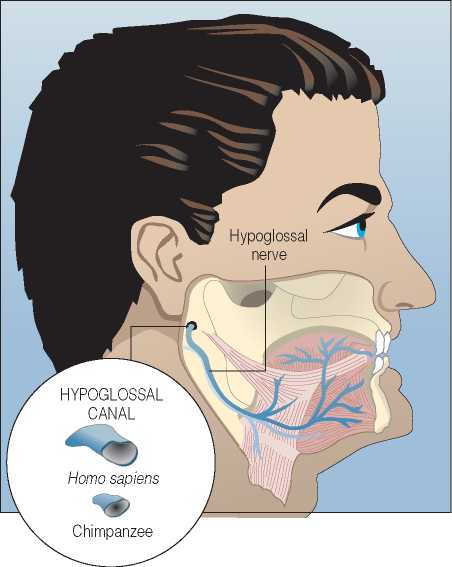Though we do not have definitive evidence of H. erectus’ linguistic abilities, indications of a developing symbolic life, as well as the need to plan for seasonal changes and to coordinate hunting activities (and cross stretches of open water), imply improving linguistic competence. Another interesting source of evidence for evolving humans’ linguistic capability is found in the fossil record. There, it is apparent that the majority of the stone tools were made by right-handed individuals, supporting the theory of the increased specialization and lateralization of the evolving brain. In other primates and most mammals, the right and left sides of the brain duplicate each other’s function; these animals use the right and left sides of their bodies equally and interchangeably. In humans, the emergence of handedness seems closely linked both developmentally (at about the age of 1 year) and evolutionarily with the appearance of language. Thus evidence of handedness in
Figure 8.7 Language areas in the left side of the brain. The right side of the human brain has different specialized functions.
Lower Paleolithic tools indicates that the kind of brain specialization required for language that is present in contemporary humans was well under way (Figure 8.7).
The vocal tract and brain of H. erectus are intermediate between those of H. sapiens and earlier Australopithecus. The hypoglossal canal—the passageway through the skull that accommodates the nerve that controls tongue movement, which is so important for spoken language—has taken on the characteristic large size seen in contemporary humans in fossil skulls dated to 500,000 years ago (Figure 8.8).120
Possibly, a changeover from reliance on gestural to spoken language was a driving force in these evolutionary changes. The reduction of tooth and jaw size, facilitating the ability to articulate speech sounds, may have also played a role. From an evolutionary standpoint, spoken language could be said to provide some advantages over a gestural one. Individuals do not have to stop whatever they are doing with their hands to “talk” (useful to a species increasingly dependent on tool use), and it is possible to talk in the dark, past opaque objects, or among people whose gaze is concentrated on something else (potential prey, for example).
23 Cartmill, M. (1998). The gift of gab. Discover 19 (11), 64.
Hypoglossal canal The opening in the skull that accommodates the tongue-controlling hypoglossal nerve.

Figure 8.8 The size of the hypoglossal canal is much larger in humans than in chimpanzees. The nerve that passes through this canal controls tongue movement, and complex tongue movements are involved in spoken language. All members of the genus Homo after about 500,000 years ago have an enlarged hypoglossal canal.
With H. erectus, then, we find a clearer manifestation of the interplay among cultural, physical, and environmental factors than ever before. However slowly, social organization, technology, and communication developed in tandem with an increase in brain size and complexity. In fact, the cranial capacity of late H. erectus is 31 percent greater than the mean for early H. erectus, a rate of increase more rapid than the average fossil vertebrate rate.24




 World History
World History









